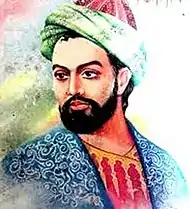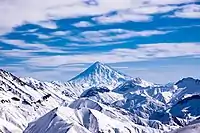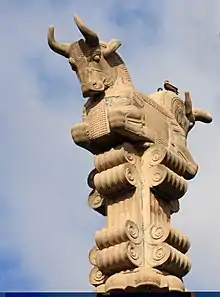Amol
Amol (Persian: آمل – [ɒˈmol]; ![]() pronunciation ; also Romanized as Āmol and Amul)[4] is a city and the administrative center of Amol County, Mazandaran Province, Iran. In the 2006 census, the surveyed population of the city was 197,470, in 55,183 families.[5]
pronunciation ; also Romanized as Āmol and Amul)[4] is a city and the administrative center of Amol County, Mazandaran Province, Iran. In the 2006 census, the surveyed population of the city was 197,470, in 55,183 families.[5]
Amol
آمل Ancient names: Amard, Amerdad, Ameld, Amui, Hamo, Tabaristan, Ameleh, Amol | |
|---|---|
City | |
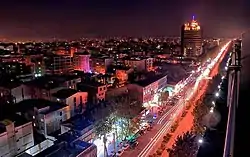 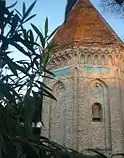  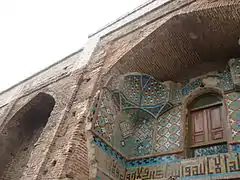   | |
 Seal | |
 Amol | |
| Coordinates: 36°28′11″N 52°21′03″E | |
| Country | |
| Province | Mazandaran |
| County | Amol |
| Bakhsh | Central |
| Incorporated (city) | 1923[1] |
| Government | |
| • Mayor | Hamid Hashemi[1] |
| Area | |
| • City | 21 km2 (8 sq mi) |
| Elevation | 76 m (249 ft) |
| Population (2016 census) | |
| • Urban | 238,528[2] |
| • Metro | 364,692 |
| Time zone | UTC+3:30 (IRST) |
| • Summer (DST) | UTC+4:30 |
| Postal code | 46131-46391[3] |
| Area code(s) | (+98) 11 |
| Website | Amol.ir Amol.gov.ir |
Amol is located on the Haraz river bank. It is less than 20 kilometres (12 mi) south of the Caspian sea and is less than 10 kilometres (6.2 mi) north of the Alborz mountains. It is 180 kilometres (110 mi) from Tehran, and is 60 kilometres (37 mi) west of the provincial capital, Sari.[4] Amol It is one of the oldest cities in Iran, and a historic city, with its foundation dating back to the Amard. In the written history, Amol, in the Shahnameh, has been one of the important centers of events. Amol the center of industry and the pole of culture of Mazandaran, the rice capital of Iran, one of the most important cities of transportation, agriculture, tourism and industry in Iran, one of the dairy and meat products centers of Iran and is known as the History, Science and Philosophy city, City that does not die and Hezar Sangar city.[6]
History
Pre-Islamic
Ammianus Marcellinus says the name the Amol city is derived from the people Amard.[7]
In fact, Amol is one of the most ancient cities of Iran. A number of historians and geographers believe it was established in the 1st millennium BC. Some historians have attributed the rise of the city during Tahmuras.[8]
Pishdadian and Amard

Some past historians have associated this ancient city with the periods of the Pishdadian dynasty and the Kayanian dynasty. Amards were the people inhabiting the area before the arrival of Aryans, who had migrated to and settled on the Iranian Plateau from the late 2nd millennium BC to early 1st millennium BC. Many scholars believe that the city's name is rooted in the word Amard (Amui in Pahlavi).[9] Amol is an old city, with a history dating back to the Amards. Amards were the people inhabiting the area before the arrival of Aryans, who had migrated to and settled on the Iranian Plateau from the late 2nd millennium BCE to early 1st millennium BCE. Many scholars believe that the city's name is rooted in the word Amard (Amui in Pahlavi). According to historical literature, Amol was the capital of Mazandaran, at least in the period starting from Sassanid Empire to the Ilkhanate dynasty of Mongol Empire. Though they are a Median tribe, Herodotus names a tribe called Mardians as one of the ten to fifteen Persian tribes in Persis. It is now known that the only distinction between the Median Amardians and the Persian Mardians is the 'a' in the beginning of Amardians, which would mean they are two different tribes. Elsewhere he says, one of the peoples who have trusted Darius I[10]
Igor M. Diakonoff says, Amardian lived in the coasts of the Caspian Sea, in the distance of the Alban and Otia from the north and the Hyrcanian from the east.
Strabo says about Amard people, the Amard wore black robes, had long hair and everyone was braver. He was also allowed to marry any woman. In the history of the Persian Empire, the Mard were handsome, capable and brave persons presented in the heart of the army and were responsible for defending the commander.[11] The Amard helped Achaemenid in several battles including the invasion of Greece, the occupation of Sardis, the attack of Medes and at the Battle of Opis. The other theory about Amol via Ibn Isfandiyar says, at the request of wife Firoz Shah, he created a large and flourishing city named Amele.[12]
Achaemenid Empire
People of Amol were the people of Amard they were one of the most important Achaemenid satraps who were the guardians of the Amard Sea, the current Caspian Sea.[13] Further evidence of the power of the Amol people is their fighting in the Battle of Thermopylae, Battle of Gaugamela and other Sardis forces in the Achaemenid Empire.[14] Quintus Curtius Rufus said, Immortals (Achaemenid Empire) Archers they were all Amard people.[15]
Parthian Empire
During the age of the Parthian Empire, Amol was one of the centers of Iran. It seems that Amol's reputation in the time of Alexander the Great and the Parthian period dominated the political-administrative Satrap was Hyrcanian.[16] During the Parthian period, Amol was also famous and prosperous, which was called Homo or Hamo. Parthian King Phraates I (171-173 AH) defeated the Mardas in the Amol region. He is said to have moved a group of people to the Parthian lands in northern Khorasan and settled in western Amu Darya, also known as Amol Zam.
Sassanian
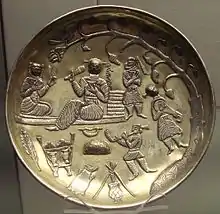
According to historical literature, Amol was the capital of Mazandaran during the period starting from the 3rd century CE under the Sassanian Empire to the 13/14th century CE under the Ilkhanate dynasty of Mongol Empire. Before Islam, Amol was one of the largest and most important cities in the region and was considered the center of Mazandaran. The city of Amol existed before the Sassanids and during the Alexander period. During the Sassanid period, the importance of this Amol was increased due to the escape of the followers of Mazdak to this city. Based on pieces of evidence, including the coins found during excavations in addition to Muslim historical books, Amol was the capital of Mazandaran province during the Sassanid Era. According to historical literature, Amol was the capital of Mazandaran during the period starting from the 3rd century under Sassanian Empire to the 13/14th century under the Ilkhanate dynasty of Mongol Empire. On Sasanian coins, coin cities where there has been abbreviated name is known, but mark m was Amol. During the Bahram V Amol were Central of Iran and at during the Khosrow II and Dabuyid dynasty capital Mazandaran. Amu Darya Sasanian mid pers river about 2,500 km long, regarded in ancient times as the boundary between Iran and Turan, the modern name may be derived from Amol.[17] In city during this period has Temple, Market, fireplace there was. Ibn Rawi in his book calls Amol bigger than Isfahan and Qazvin.[18]
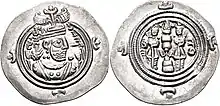
In Hudud al-'Alam says about Amol, is great city with most moat and castle, the universe and origin of merchants and at city Carpet, mat, boxwood, bowl, brick and medallion is found.[19]
Herodotus in Histories say, mentions the tribes of the Tabaristan the Mard or the Amards In the time of the king Darius the Great from influential and tribes people. During the Sassanid period, the city of Amol enjoyed development and was the center of the important province of Tabarestan. During its development, the city had infrastructures and elements such as government citadels, neighborhoods, fire temples and bazaars. During this period, Amol had a fire temple in the area, called name Avam Kuye.[20]
Dabuyid dynasty and Bavand dynasty Iranian dynasty, were the kings of the Sassanid dynasty, they lived in Amol and it was the city capital of these dynasties.[21] The coins of Ispahbudhan of Tabarestan and the Arab and Sassanid periods have been minted in Amol mint and sometimes in Sari. It can be argued that the mints of several cities in Mazandaran, especially Amol and Sari, such as the city of Gorgan, was have been engaged in minting various coins for 1,300 years.[22]
Abbasid, Alid, Ziyarid, Marashis
Amol, in the era of the Alid dynasties and Marashis dynasty, was the capital of Northern Iran. The inhabitants of Amol embraced Islam during the reign of Mahdi (775–785), the Abbasid Caliph. Amol was also the capital city of the Bavand dynasty and Ziyarid dynasty. The people of Amol initially resisted the Arabs. Today, Amol is a thriving modern metropolis. In the Abbasid Caliphate of the ninth century, Amol was one of the largest cities in Iran. Khalid ibn Barmak built a palace in the city and ruled for years. People from the Qarinvand dynasty arrived a couple of years and fought with the Abbasid Caliphate to win the kingdom. During the Umayyad Caliphate period, during the reign of Muawiyah I, Sa'id ibn al-As undertook the conquest of Tabaristan, and with an army of 4,000 troops rushed there, and the whole war between him and Farrukhan the Great lasted for two whole years, but was postponed. The conflict lasted until Abbasid Caliphate until the attack of the Persian general Wandad Hurmuzd.
In Hudud al-'Alam, Amol is regarded as a great city with active commerce and trading ventures.[23] However, resentment with the Tahirids rule increased due to the oppressive activities of their officials. People of the provinces pledged alliance to Hasan ibn Zayd. Zayd became the founder of the Zaydid dynasty of Tabaristan Alavids government in Tabaristan established and it's with Amol centered and 106-year domination of the Abbasids in the territory ended.[24] Yaqub ibn Layth the was geostrategy in Amol. Hasan al-Utrush with a trip to Amol who re-established Zaydid rule over the province Tabaristan in northern Iran in 914, after fourteen years of Samanid rule. After the Alid dynasty, the Ziyarid dynasty ruled Iran and Tabaristan. At this time Amol was developed in such a way that geographers have written articles about the industry and its silk.[25] Hasan ibn Zayd, nicknamed al-Dai al-kabir, appeared in the Tabaristan region in 250 AH, and many dissatisfied people and the captives of the Caliph Tahirid strengthened him. He invited people and published the Shiite religion. After coming to power in Tabaristan, Daei Kabir moved his capital from Sari to Amol, which was Taherian's seat.[26] In 260 A.D., Ya'qub ibn al-Layth al-Saffar marched on Tabaristan and entered Amol after the departure of Hassan ibn Zayd, but his rule did not last long and the Alavids recaptured the city again. The Alawites ruled the city until Ziyarid and Buyid, who were the handmaidens of the Shiites. The people of Amol were very militant and stood up to the Arabs, but social injustice and class divisions led the people to convert to Islam.[27]
Qabus was in 1012 overthrown by his own army, and was succeeded by his son Manuchihr, who quickly recognized the sovereignty of Mahmud of Ghazni, and married one of his daughters. Manuchihr died in 1031, and was succeeded by his son Anushirvan Sharaf al-Ma'ali whom Mahmud of Ghazni had chosen as the heir of the Ziyarid dynasty. From 1032 to 1040, the real power behind the throne was held by Abu Kalijar ibn Vayhan, a relative of Anushirvan Sharaf al-Ma'ali. During this period, Amol was chosen as the capital of Iran and until 1090. He also the first seminary by Hasan al-Utrush built in Amol, which was later named Imam Hassan Askari Mosque. The subsequent Afrasiyab dynasty flourished in the late medieval, pre-Safavid period; it is also called the Kia dynasty. It was founded by Kiya Afrasiyab, who conquered the Bavand kingdom in 1349 and made himself king of the region, in Amol.[28][29] In this period Sheikh Khalifa Mazandarani of Amol, was a leader Sarbadars.[30] Amol during the ministry of Khajeh Nizam al-Mulk Tusi in the Seljuq dynasty, along with the big cities of that time, the Islamic world Nishapur, Balkh, Herat, Baghdad and Isfahan had a prestigious Nezamiyeh modern school.[31]
Safavid
In time of the Safavid rulers of Mazandaran, Amol experienced a period of growth. The city was the favorite dwelling of Abbas II of Persia, who often frequented it. At the time Amol was considered "the capital of the inhabited world" and acclaimed for its grandeur. Several bridges were built in the area, across the Haraz river, at this time. During the Safavid era, especially during the reign of Abbas the Great, Mazandaran was considered and a road from Astarabad and Sari to Amol was built.
 The extent of the Parthian Empire (shaded territory)
The extent of the Parthian Empire (shaded territory)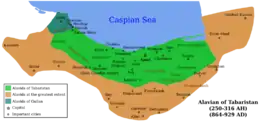 Map of the Alavid emirate with Amol as their capital
Map of the Alavid emirate with Amol as their capital Latin (1689): Sea Amard
Latin (1689): Sea Amard
in town was founded through trade center position and business centers already exceeded and founded artillery. The town has spacious and well-supplied bazaars and post and telegraph offices. Excavations in Amol at Hall of Fame have uncovered glazed ceramic and glass belonging to Islamic and modern periods[32] But after the Mongol invasion, the region was subject to devastation and it was during this time that Sari was declared as capital. In the beginning of the 7th century, Hessamedin Ardeshir, shifted the capital from Sari to Amol and constructed his palace there. At this time, a Palace and Ab Anbar was built by the order of Shah Abbas, and the tomb of Mir Ghavam al-Din (Mir Bozorg), which had been destroyed by Timur's agents, was magnificently rebuilt.[33] Amol recovered a certain measure of prosperity while ruled by the Marashiyan and the Safavids under the latter it was a center of the province of Mazandaran. Since then it has never played a leading part in Persian national affairs, being surpassed in population by Babol and by the administrative capital of the province Sari, it has also suffered at various times from earthquakes. In continuation, Haraz River crosses the city of coal and iron mining region of Amol much iron can also have it in the past.[34]
Afsharid
Amol in Afsharid dynasty and Zand dynasty as a city for trade and construction were instruments of war. In During the Nader Shah in town was founded Iron plant through trade center position to make cannonballs, mortars and horseshoes and business centers already exceeded and founded artillery. This was the first artillery workshop in Iran[35] Jonas Hanway came to Iran at this time and visited Amol and says about this city, Due to the abundance of iron ore mines, by Nader Shah order, Amol it became the most important foundry and steel plant, where cannonballs, rifles and horseshoes were produced, and Nader Shah it was even decided to build the Iranian Navy in Amol.[36] At first, the people and rulers of Larijan[37] and Amol, in support of Zand dynasty, resisted Agha Mohammad Khan Qajar and defeated him.
Qajar
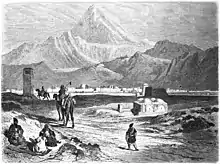
In the Qajar era, road and railway from Tehran to Amol, Amol was pulled from Mahmoudabad. Ibn Hawqal says, the geographers of the 4th to 10th century describe Amol great prosperity and prosperity, in the latter respect, according to Ebn Ḥawqal, it surpassed Qazvin. Its inner city was protected by a moat, and the houses were constructed of wood and reeds rather than mud bricks on account of the heavy summer rainfall. Rice, fruits, and vegetables grew profusely, and the town was a center for the fabrication of wooden articles, textiles, and carpets, the silks being especially famous. Amol port on the Caspian was the little town of named Ahlam or Ahlom.[38] James George Frazer entered Iran in 1238 as a merchant and scientist and said about this city in his travelogue, the city truly great and vast. people were decent and respectable inhabitants of the city. Several leaders of the Iranian constitutional revolutions of 1905 and 1911 hailed from Amol. Mulla Ali Kani, one Amoli people reformist who led the people, had a great role in achievement to the goals of Iran's constitutional revolution. During this period, was built many homes in the city. Although today Amol has expanded greatly on both sides of the Haraz river, its functions are still the same as they were seventy or eighty years ago.[39] The Amol cotton cleaning plant was built in 1906 by the Russians. Prior to that, two company Rosenblum and Osser in one of Amol borough that is, Barforoush was active.[40] In the 19th century, Amol iron and iron goods were traded all over Iran and as far abroad as Baghdad, Mosul and Damascus. Today, the main industries are food processing factories rice, minor woodworking shops, and a few brickworks.[41] Pierre Amédée Jaubert say, the Dispatch ambassador Napoleon Royal court Fath Ali Shah Qajar visited Amol and mentioned in his book about the Haraz River and the centralization of Steel workshops on its shores.[42] Although today Amol has expanded greatly on both sides of the Haraz river, its functions are still the same as they were seventy or eighty years ago. Besides being one of the county centers of the province of Mazandaran, it is a busy commercial center. In itinerary book says, Amol is a magnificent city with 4 gates, although there is no gate installed, namely Darvaze Tehran or Larijan, Barforosh, Taliksar and Nour.[43]
After the fall of the Mongols, the Marashians appeared in Mazandaran. In 760 AH, Mir Ghavam al-Din Marashi established the Marashis government. The Marashis uprising began in Amol. After gaining power, the Marashians soon occupied all the lands and areas around Mazandaran and expanded their territory from Gorgan to Qazvin and Isfahan.[44][45]
In interval Persian Campaign, Community Tabaristan by Amir Movayed Savadkoohi, with, the support Influential men of Amol, founded to oppose the British and the Russians. Vsevolod Starosselsky in Amol build a Headquarters for capture it other cities in Mazandaran. Mirza Kuchak Khan To deal with him, entered Amol through the port of Ahlam with Khan's Amol and left the city after a long involvement against Persian Cossack Brigade.[46]
In this epoch, with the support of the Shah and the wealth of Amin al-Zarb, the first modern railway in the history of Iran was established in Amol.[47] Twenty-one kilometers of railway linking Amol and the iron mines of Mahan Nour{[dn|date=October 2020}} to the Caspian port of Mahmoudabad in the name of Naseriyah. In 1887, the project prompted of Amin al zarb after three visits to Europe and the contract for the construction of the railway was signed with the British company Quzi and a Belgian company. In the end of the reign of Naser al-Din Shah Qajar, railway it was completed in 1891 but never used due to the involvement of local people and Russians. About 700,000 tomans were invested for project.[48][49] Following the development technocracy policies of Iran by Amin al zarab, was established the first Steel mill of Iran in Amol. In 1887, Amin al zarb obtained an exclusive permit from Nasser al-Din Shah for 30 years to establish a smelter, and bought an eight-meter furnace with a production capacity of 15 tons of iron from France on for 24-hour and settled in Amol.[50][51]
Pahlavi, Islamic Republic of Iran
During the reign of Reza Shah Pahlavi, the face of the town was changed drastically. Schools and most of the streets and governmental buildings current Amol date from that era. During this period, by the order of Reza Shah, Austrian and German engineers, they built Moalagh Bridge, Municipal mansion, Municipal hotel, Chaikhori palace, Pahlavi high School, Asset building and Rice warehouse for export. During this period, the construction of an alternative Haraz road, it was handed over to the Russian company Treskiniski by the Reza Shah.
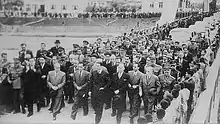
Hyacinth Louis Rabino, with visiting Amol during this period, described Amol as an open town with four gates, nine quarters, and approximately 2000 houses. A large bazaar contained about 400 shops with many traditional crafts and trades.

In the during Mohammad Reza Pahlavi, The construction of Taleb Amoli Street in the western part of the old city and its extension in 1973 to 1975 was completed and the texture of the city was changed. Street Shahpur, Street Reza Shah Kabir, Street Farhang, Street Saadi, Shir-o-Khorshid Hospital, Imamzadeh Abdollah and Spinning, weaving and textile factories were built. Road 77, Sepah-e danesh school, Paddy factory, Grundig and Kubota in Iran it came to fruition in 1963. Supporting Abali hotel, Rineh tourism center and Reinforcement of Amol port it was done as a tourism project. During this period, the municipal sewage system and electricity were modernized.[52] During this period, behest to Reza Shah the railway between Tehran and Amol began seventeen years ago, and gradually a large part of it was built, except for sixty kilometers between Abegarm and Amol, Which totally stopped construction in September in the beginning Anglo-Soviet invasion to Iran.[53] In the end of the kingdom an agreement was signed between the Ministry of Agriculture of the Pahlavi Government of Iran and the Ministry of Economic Affairs of the Republic of China on the extension of agricultural technical cooperation to develop research and increase rice production, and was implemented at the Amol Rice Research Institute of Iran.[54]
With the beginning of the Islamic Republic of Iran The forest uprising implement. The Jungle Uprising in 1982 of the Union of Iranian Communists (Sarbedaran) mobilized its forces to jungles around Amol and started some wars against the Islamic Republic in those jungles. It finally organized a famous uprising on 25 January 1982. The Communist Union, based on its Maoist policy, and with its mindset of guerrilla and peasant wars, establishment on the outskirts of Haraz Road pathway of several important provinces and cities of the country and suitable camouflage of Amol forest and mine reasons to choose in the forest its strategy for war. the union has assassinated 600 people during three operations in Amol in Nov 9 and Nov 13 1981 and January 25, 1982. the Mojahedin used machine guns and rocket-propelled grenade launchers against units of the Pasdaran. Smaller left-wing opposition groups, including the Organization of Iranian People's Fedai Guerrillas, attempted similar guerrilla activities. In July 1981, members of the Union of Communists tried to seize control of the town of Amol. This uprising was a failure and most of the Maoist and UIC leaders were hanged but the uprising itself became very famous and is well respected among some Iranian Leftist organizations. It also experienced various theoretical and political crises. The clashes lasted from November to February for four months.
This day became known in the Iranian calendar named Epic 6 Bahman or Epic of the People of Amol.[55] After this incident, Ruhollah Khomeini only mentioned the name of the city of Amol in political and divine testament and wrote, We have to thank the people of Amol.[56]
21st century
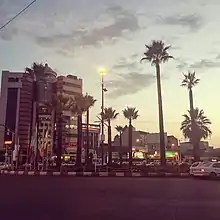

Some of the most recent projects have been the complete restoration of the Bazaar and of the Imam reza street, as well as a comprehensive plan for the preservation of the old city quarters. A lot of different construction projects are currently underway, which intend to modernize the city's infrastructure. In the last few years, many square, towers, boulevards and bridge were built in Amol. For example, Haraz Street one of the most modern streets of northern Iran. Amol is growingly turning into an industrialized town like most of the Iranian large cities. Today, Amol is a thriving metropolis. One of the things they really lack is an airport so there are no cheap flights to Amol. Some of the most famous companies in Iran have main offices located in this city. Good secondary and tertiary education is being offered here as well. Islamic Azad University, for instance, is one of the biggest universities in the Middle East. Now in Amol there municipality and special governor. Amol is one of the research centers for scientific development, knowledge-based sciences and Science and Technology Park of Iran. At present, Amol, as the center of dairy and livestock products, mining sand, nurture products such as meat, flowers and fish and production rice of Iran. It Industrial machinery products is also very popular in Amol and Iran Heavy Diesel Factory is located in Amol Industrial Town.[57]
At present especially since 2017, in addition to mass construction of residential buildings, the construction of small streets and hall sport in the deprived areas of the city has accelerated.[58]
Bitter events
- Amol Gullies were completely destroyed. Since Sasanian Empire then the town has suffered earthquake and flood damage several times, but each time has recovered, and it is still a considerable town. During the Pahlavi dynasty, the city was burned twice dore to fire.[59][60][61][62]
- Flooding in Mount Deryouk, and the destruction of entire city.
- Dangerous diseases that plague the year 1198 AH
- The outbreak of the dangerous plague that took place in 1198 AH destroyed countless civilians
- The war of the local kings with the Arabs
- Mongol invasion of Genghis Khan and his descendants to Tabaristan
- Wajih ad-Din Masud attack in Amol
- Battle Alavid and Saffarian Samanid in Amol
- Battle House of Karen and Bavandids in city
- Samanid Empire attack to royan and Amol with House of Ispahbudhan
- Timur war with the kings Marashis and killing people and battle with Iskandar-i shaykhi
- Attack Mas'ud I of Ghazni on the city
- Shah Ismail I and Shah Abbas Safavid King wars attack the Amol and killing people
- Agha Mohammad Khan Qajar attacked the Larijan and Amol, killing people and destroy the city
- Conflagration in 1335 AH which caused a lot of damage and severe destruction of the city. This fire and fire occurred in the year 6 AH, which first started near the Niyaki ridge and was swept across the city by the wind and reached the Haraz River and caused a fire to the gunpowder shop and ammunition shop. The shop exploded and a terrible fire broke out across the river, and then the whole city of Amol was blown away by the wind. It is known that the fire took place in April, when residents were enjoying the Nowruz celebration, and much of the city was turned gray
- Sangchal (Bandpay) Earthquake of 2 July 1957
- Destroying people with Disease glanders
First of Iran
- The first steel mill in Iran[63][64][65]
- The first artillery and gunpowder workshop in Iran[66]
- The first foundry in Iran[67][68][69]
- The first modern railway in Iran[70][48]
- The first banknote printing factory in Iran[71]
- The first road building in Iran[72]
- The first commercial port in northern Iran[73][74]
- The first cotton gin factory in Iran[75]
- The first mineral water factory in Iran[76]
- The first mdf wood factory in Iran[77]
- The oldest seminary in Iran[6]
In literature
.jpg.webp)
The first Aryan dynasty mentioned in Ferdowsi masterpiece at the Shahnameh. The name Amol has come up 16 times directly in Shahnameh. In the Persian epic, Shahnameh, Mazandaran is mentioned in two different sections. The first mention is implicit, when Fereydun sets its capital in city called Amol:[78]
|
بیاراست گیتی بسان بهشت
|
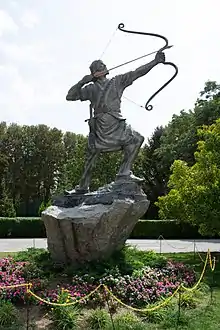 The statue of Arash the Archer Hero Iran Arash in Amol threw an arrow to determine the Iranian border, Arash throw from the castle with Amol sequel and its agents to reach the border to have called Turan. The arrow flew the entire morning and fell at noon on the far bank of the Oxus River in what is now Central Asia.[79] از آن خوانند آرش را کمانگیر
|
Geography
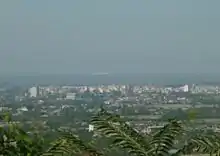
The city has Mediterranean climate with very hot summers and cool and humid winters. Maximum rainfall is usually in the month of December and minimum in the month of July. Amol is located on the banks of the Haraz River (26 25'N 52 21'E) at an altitude of 76 m above the sea. It is about 18 km from the Caspian Sea and about 10 km from the northern Alborz mountains. It is 180 km from the Iranian capital, Tehran, with a picturesque drive through Haraz Road. Sari the capital of Mazandaran is 70 km east of Amol. Mount Damavand (5610 m), the highest peak in the Middle East, is located south of Amol. Amol, with its elevated landscape and valleys, has dense forests. Its tall hills overlook the plains and stretch out till the high slopes of the Mount Damavand. The majestic and deep rocky valleys, rivers, numerous springs, elevated waterfalls, colorful vegetation, a variety of wild life, thermal springs, summer quarters, and rural settlements are some of the special factors which can prove attractive.[80]
Ecology
Amol has it lot of dense forests and pastures. The ecology of Tabaristan region had been an impediment to provide a regularly communicative path and Haraz path is one of the oldest ones that had communicated the north of Iran to the central plateau in different periods. This study attempts to deal with archaeological data of this communicative path in Sasanian period and at the beginning of Islam. A descriptive-analytical method and scaling archeological investigation in region has been used in the study.[81] the vegetation of the region can be divided into forest and grassland. Caspian horse It is also called Khazar Horse to be found the first time in Amol rediscovered in 1965 by Louise Firouz. also Mazandaran tiger there in the jungle Amol city.[82]
Coherent
Haraz Dam is the biggest dam north of Iran under construction on the Haraz River about 20 km from Amol of the year 2009 by Khatam-al Anbiya Construction Headquarter. It is a 150-meter earth rockfill dam with 8.6 million cubic meters of fill volume.[83]
JGC Corporation has also held talks to build a waste-to-energy plant, also known as waste incinerator, in the city of Amol in the northern Mazandaran Province.[84]
Climate
Amol has short, but hot summers, and long springlike winters. Köppen-Geiger climate classification system classifies its climate as hot-summer Mediterranean (Csa).[85]
| Climate data for Amol | |||||||||||||
|---|---|---|---|---|---|---|---|---|---|---|---|---|---|
| Month | Jan | Feb | Mar | Apr | May | Jun | Jul | Aug | Sep | Oct | Nov | Dec | Year |
| Average high °C (°F) | 13.1 (55.6) |
12.5 (54.5) |
12.4 (54.3) |
16.2 (61.2) |
23.7 (74.7) |
27.7 (81.9) |
28.7 (83.7) |
30.3 (86.5) |
25.9 (78.6) |
23.2 (73.8) |
18.9 (66.0) |
15.1 (59.2) |
20.6 (69.2) |
| Daily mean °C (°F) | 8.7 (47.7) |
8.1 (46.6) |
8.2 (46.8) |
11.9 (53.4) |
19.1 (66.4) |
21.9 (71.4) |
24 (75) |
25.4 (77.7) |
21.1 (70.0) |
18.4 (65.1) |
13.8 (56.8) |
10.2 (50.4) |
15.9 (60.6) |
| Average low °C (°F) | 4.4 (39.9) |
3.8 (38.8) |
4 (39) |
7.7 (45.9) |
14.6 (58.3) |
16.2 (61.2) |
19.3 (66.7) |
20.6 (69.1) |
16.3 (61.3) |
13.6 (56.5) |
8.7 (47.7) |
5.4 (41.7) |
11.2 (52.2) |
| Average precipitation mm (inches) | 96 (3.8) |
80 (3.1) |
74 (2.9) |
69 (2.7) |
31 (1.2) |
27 (1.1) |
27 (1.1) |
36 (1.4) |
87 (3.4) |
97 (3.8) |
97 (3.8) |
108 (4.3) |
829 (32.6) |
| Source: Climate-Data.org, altitude: 96m[85] | |||||||||||||
Weather
The climate of Amol city is similar to other parts of Mazandaran; in hot and humid summers and mild winters. The maximum amount of rainfall falls in December and the least in July. It has a special climate in its regions.
Excavation sites
In recent years, on the excavation hill Qaleh Kesh, some ancient jewelry was discovered. Radiocarbon analysis revealed the background of the jewelry and objects to date from the 1st millennium BC, Bronze Age. New to explore in Baliran works of the era found Paleolithic.[86]
Population
The population history of the city proper is as follows. All figures are official census figures from the Iranian Statistics Institute.[87]
| 1956 | 1966 | 1976 | 1986 | 1991 | 1996 | 2006 | 2011 | 2016 |
|---|---|---|---|---|---|---|---|---|
| 22,251 | 40,076 | 68,963 | 118,242 | 139,923 | 159,092 | 197,470 | 219,915 | 238,528 |
Breakdown of 2006 census:[5]
| Total | Male | Female | Family |
|---|---|---|---|
| 197,470 | 98,337 | 99,133 | 55,183 |
Language, religion, timeline
Most Amoli people speak the Mazandarani language Tabari as a mother tongue; however, Persian is the most common language spoken in Iran and the lingua franca. Northern provinces of Iran in the Parthian or Sassanid period, probably, was Zoroastrian. There is clear temples in the province. Mazandaran people converted to Islam around the second century AH. Amol as the first prime city center was a Twelver Shiite theocracy. At present, the majority of people are followers of Shia Islam. Amol, mazandaran has its own calendar months in addition to the official Tabari calendar of the moon, used in the era of Yazdgerd.[88] Based on experiments and research Max Planck Society, The people of Mazandaran have long been the most original people living in Iran.[89]
Economy
Amol is the center of dairy, Poultry and livestock products, Steel building and rice in Iran. Mineral water, meat, dairy, Wood, Metal machine products and ingots the main production industrial are in city. Agriculture and Tourism are the basis economy Amol economic base is in its provincial products. Agriculture has always been a major part of the economy in and around Amol.
Amol is the economic center of Mazandaran province, with Agriculture and Tourism being the base of the Amol economy. Rice, grain, fruits, cotton, tea, sugarcane, and silk are produced in the lowland. Mineral water, meat, dairy, wood and ingots are the main manufacturing industry.[90] 68% of exports of Mazandaran in Amol done.[91][92] In the 18th century - 19th century, Amol iron and iron goods were traded all over Iran and as far abroad as Baghdad and Damascus and The society of linen, rice, handicrafts, honey, wood, mat and gold to trade house in Rome and the Gulf countries.[93] Now export Food products, Citrus, Ornamental flowers, Cement and sand, Meat products, Industrial machinery, Rapeseed, Power cord, Electronic equipment and Mineral water is exported to several countries, including Afghanistan, Russia, Netherlands, Iraq, Pakistan, Turkmenistan, Turkey, Oman, Qatar, Angola, Oman, United Arab Emirates, Azerbaijan and Germany.
Rice
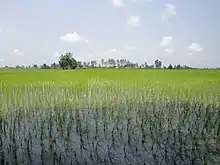
The Rice Research Institute of Iran, has been established in 1963 and through its 50 years of research activity, it has had significant impacts on the rice cultivation in the region. The Rice Research Center is located in Amol.[94] At the ceremony opening of Haraz Road, Mohammad Reza Shah Pahlavi introduced Amol as the capital of rice and science. Winston Churchill stated that Tehran was supplied with rice by Mazandaran because of transportation facilities through the Amol. Amol rice is considered a high quality product and is exported across the world. Iran's rice export terminal at Amol was established 2016.[95] Iran International Rice Trade Center and Export Terminal was inaugurated of Amol, on 21 Aug, 2019 in the presence of First Vice President Hassan Rouhani. The center has been established with private investment amounting to over 1 trillion rials ($8.58 million) on earth over 17 hectares.[96][97] Nowadays, is rice seedling celebration every year in Amol.[98]
Industry
Amol of primary cities in the production of bricks, tobacco, rice, paper and guns from thousands of years ago. Ultra Quality Rice and Fresh Fruits are major products of Amol Farmers. 65% Industry Mazandaran province it is located in Amol. He is one of the centers meat and dairy products in Iran.[99] Horticulture, greenhouse the city's other important activities. The company Solico that Including Kalleh dairy and Kalleh meat one of the biggest corporations in Asia located in Amol.[100] Currently, three industrial town is active in county named, Industrial Estate, Amol, Babakan Industrial Estate and Tashbandan. also Iran Heavy Diesel Manufacturing Company, the car and ship's locomotive engine maker is based in Amol. Security paper of Iran producer of securities, banknotes, checks, passport pages and birth certificates it is produced by Takab in Amol.[101]
Major corporations
"Domestic companies"
|
|
"Foreign companies"
- Nestlé Pure Life
- Hochland SE
Native
Pottery is common in the city. Pottery is the material from which the potteryware is made, of which major types include earthenware, stoneware and porcelain. The place where such wares are made is also called a pottery. Pottery also refers to the art or craft of the potter or the manufacture of pottery. There are also fish farming center in the foothills and around the city, including trout and sturgeon. Today, the percentage of aquaculture production in Amol is equal to the Caspian Sea.[114]
Culture
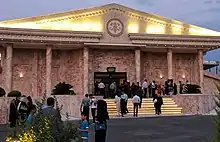
Amol long history has ancestors because of intellectuals and local and national events. depending on the culture of the people some of the ancient ceremony of Mazandaran Islamic traditions mingled, Amol is a center for Iranian culture and has produced a number of famous poets. Wool, felting, felt hat production and mat weaving are part of the Amoli culture. Varf Chal, Locho Wrestling, Palm and Tiregan named Damavand National Day are local events held each year. Tirgan important celebrations in Iran's history.[115] In Mazandaran, this day is known as Tir Maah Sizdah Sho. The name literally means 13th night of the month of Tir. It occurs on 12th of Aban, the 8th month of Persian calendar, and is celebrated in province of Mazandaran. Its history goes back to pre-Islamic era of Iran, and is mentioned in accredited history book of Tarikh Tabari. The celebration has specific procedure, 13 different kinds of edibles are prepared and members of the household should stay home for that special night. Tiregan is one of the biggest festivals in ancient Iran. Traditionally, it is held on the Tir day (ancient days) of Tir month, equal to the 13th of the month in the Zoroastrian calendar, and equivalent to the 10th of Tir in Shamsi year.
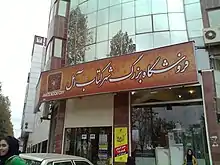
Tiregan is celebrated on 13th on Tir in the foothills of Rineh city of Larijan in Amol, Mazandaran Province. It is celebrated by splashing water, dancing, reciting poetry, and serving traditional foods such as spinach soup and sholezard. The custom of tying rainbow-colored bands on wrists, which are worn for ten days and then thrown into a stream, is also a way to rejoice for children. other ceremony is called Varf Chal, Every spring, people in Ab Ask, a village near the northern city of Amol, mark a 600-year-old ceremony called Varf Chal, which literally means snow storing.
Nowruz Iranians celebrate ancient is also important in Amol. Nowruz Khani, or singing for Nowruz, is a Tabari Gilani tradition in which in the latest days of the year before the Persian New Year (Nowrooz), people go at the door of their neighbors and sing songs about the impending coming of the spring. Locho wrestling is held in the north of Iran in Mazandaran as a traditional, frankly and ancient sport for 1600 years. This wrestling, which is also known to be the Locho heroic sport, has a particular position in the culture and valuable beliefs of the locals and now, it has been a national registered heritage. Amoli people are said to spend much on books, clothes and food. They spend the leisure times going to cinemas, art exhibitions, music concerts and international book fairs that are being held in the city most of times in a year. Amol is known as the city of Mystics and philosophers, Hezar sangar, Productive and Alavian. Amol has been host Fajr International Theater Festival and Jasmine International Film Festival.[116]
Old city
Old district of Amol
The main body of the old city of Amol is located in the old bazaar Amol. The old bazaar is the main pillar and core of the city's organizer, and its original existence dates back to before Islam and its core 900 years ago. The main constituents of the city Bazaar Amol known as Paein Baazar or Bazaar Chaharsogh situated in the city center, has lost some of its former importance due to social, economic and historical reasons. The roofs of the shops here are made of earthenware tiles on an incline so as to be a protection against the sun and rain. The open spaces within, are used to set up weekly bazaars. Historic mosque and old houses located along market and tribe quarters of the people is also available in the market. Tuesday era Sassanid, Qajar and contemporary is evident in the alleys of the market and its neighborhoods.[117]
Older neighborhoods
|
 Manouchehri House in old Amol
Manouchehri House in old Amol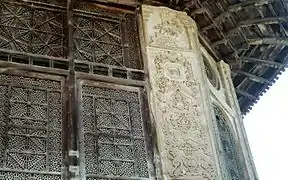 Window Shafahi House in old Amol
Window Shafahi House in old Amol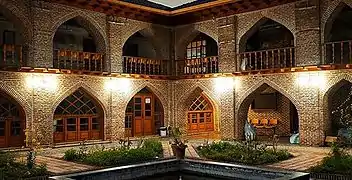 Agha Abbas Mosque in old Amol
Agha Abbas Mosque in old Amol.jpg.webp) Entrance Amol Bazaar
Entrance Amol Bazaar View of Imamzadeh Qasem in old Amol
View of Imamzadeh Qasem in old Amol
Historical and natural attractions
In City and County:
_bridge.jpg.webp)
fakhrul_islam_and_rukn_al_din_Amuli.JPG.webp)
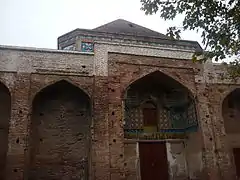
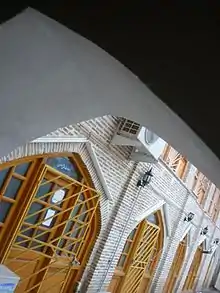
- Mount Damavand is a stratovolcano which is the highest peak in Iran and the Middle East. It has a special place in Persian mythology and folklore.
- Mausoleum of Mir Bozorg (Tomb of Qavam al-Din Marashi)[118]
- Lar Dam
- Lar National Park
- Mosque of Hasan Al-Utrush Originally a small tomb tower before renovation.[119]
- Sayyid Haydar Amoli (Seyyed Se Tan Tomb tower)[120]
- Moalagh Bridge
- Davazdah Cheshmeh Bridge
- Shahandasht Waterfall
- Amol Bazaar[121]
- Amol History Museum
- Imamzadeh Ibrahim
- Malek Bahman Castle
- Nassereddin Shah relief (known as Shekl-e Shah)
- Jameh Mosque of Amol
- Agha Abbas Mosque
- Kafar Koli Caves
- Yakhi Waterfall
- Waterfall Deryouk
- Shah Abbasi Baths
- Fire Temple of Amol (known as Shams Al-Rasol)
- The Sasanian Road
- Zaman Valley
- Tower Khidr Nabi
- Village forest Blairan
- Village forest Alimastan
- Gol-e Zard Cave
- Manouchehri Mansion
- Shafahi House
- Ab Ask Thermal Springs
- Ashraf Bath[122]
- Inn Kemboja
- Heshtel Towers
- Kahrud Castle
- Sangi Bridge Polour
- Imam Hassan Askari Mosque
- Imamzadeh Qasem Shrine
- Imamzadeh Abdollah Shrine[123]
- Mohammad Taher Shrine[124]
- Ab ask Thermal Springs[125]
- Lake Sahon
- Haj Ali Kochak Mosque
- Ab Murad Waterfall
- Sang Darka Waterfall
- Amoloo Mineral Water Spring
- Forest Park Mirza Kuchak Khan Haraz
- Forest Park Halumsar
- Ziaru Jungle
- Dehkadeh Talaei Park
- Larijan Hot Spring
- Dokhaharan lake
- Hosseiniyeh of Amol
- Plain Shaghayegh Larijan
- Gabri Tower
- Mir-Safi Baths
- Tomb Darvish Sheikh Ismail
- Robat Sangi Polur
- Prairie anemone of Polur
- Haj Ali Arbab House
- Do Berar Peak
- Sahun Lake
- Ancient Hill Qaleh Kesh
- Larijan Thermal Spring
- Rineh Thermal Springs
- Kolakchal Mountain
- Ghoredagh Mountain
- Div Asiyab Spring
- Hand Caves in Larijan
- Tekyeh Firuz Kola
- Amiri Waterfall
- Mahan Waterfall
- Lasem Ab Morad Waterfall
- Pol-e Mun Castle
- Saghanefar Hendu Kola
- Saghanefar Zarrin Kola
- Tomb of Sultan Shahabuddin
- Tekyeh Oji Abad
 Davazdah Cheshmeh or Davazdah Pelleh Bridge
Davazdah Cheshmeh or Davazdah Pelleh Bridge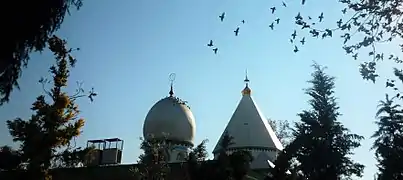 Imamzadeh Ibrahim
Imamzadeh Ibrahim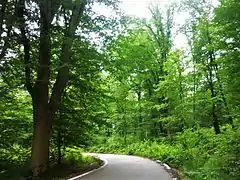 Forest Park
Forest Park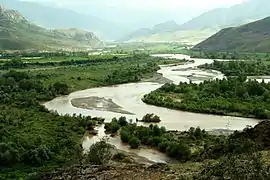 Haraz River
Haraz River Baliran
Baliran
Historical monuments destroyed
There was many other historical monuments in Amol which has been destroyed or destroyed throughout history.[126] Here is a list of most famous:
Amol government house (Dar al-Hakuma), The dome of Iraj son of Fereydoun, the house and bathhouse of Khajeh Yaghoub Majusi, Ameleh Palace and Tomb, Mashhad Sheikh Abu Turab, Sheikh Zahid Firooi tomb, Shrine Hassan ibn Hamza Alavi, Shrine of Sharaf al-Din, Shahriar Taj al-Dawla shrine, Malik Ashtar mosque and minaret, Firoozabad palace, Fortification Amol, Palace Khosrow Parviz, Parthian Fortress, Chaikhori mansion, Qal'eh Dokhtar, Afshar Soldiers camp, Khalidsara castle, Mahaneh Sar castle, Kahrud castle, Gabri tower, Eight caravanserais, Six baths, Twelve Ab anbar, Several mansions and as well as the garden and mansion of Shah Abbas Safavid.
Souvenir
- Rice (Berenj)
- Tursu (Torshi)
- Vegetable (Sabzi)
- Kilim (Gelim)
- Pottery (Sofalgari)
- Juglans (Gerdoo)
- Orange (Porteghal)
- Cherry (Gilas)
- Apple (Sib)
- Wood carving (Monabat Kari)
- Honey (Asal)
- Felt (Namad)
- Fruit preserves (Murabba)
- Local Bread (Nan Mahali)
- Pastry Ab dandan
- Pastry Aqooz Kennak
- Pastry Saghe aroos
- Naz Khatoon
- Abe Narenj
- Pisgendele
- Yogurt dalal
- Halva native
Food
- Kateh
- Kabab torsh
- Tah Chin
- Halva
- Peshte Zik
- Alu Mosema
- Morghe Torsh
- Shami Goosht
- Ash-e Doogh
- Khoresht Aloo
- Mahi Shekam Por (Stuffed Fish)
- Morgh Shekam Por (Stuffed Chicken)
- Ordak Shekam Por (Stuffed Duck)
- Ispina-Saek
- Ashure
Transportation
Air base
Amol is an air base with two helicopters relief Hilal Ahmar. This is the first center of Iran's air rescue.[129]
By rail
In 1886, during the time of Nasser-al-Din Shah, an 8.7 km 1,000 mm (3 ft 3 3⁄8 in) metre gauge horse-driven suburban railway was established south of Tehran, which was later converted to steam. This line was closed in 1952. The First Iranian railway was set up in 1887 between Mahmudabad and Amol; its construction was completely private. However it was not used because of several problems.[130][131] Now fast train north, Tehran to Amol of 2013 starts and 2020 ends.[132]
By car and bus
Amol the largest urban boulevard and highways within mazandaran in the city is. are five bus terminals, Terminal international firuzi, the largest terminal in North of Iran is. Also offers an extensive bus route throughout the entire municipality as well as numerous public and private taxi services.
Road
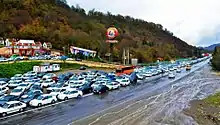
Haraz Road (Road 77) is the most important road from Tehran to northern Iran (province of Mazandaran) besidesKaraj-Chaloos. This road passes from the valley of Haraz river and therefore is also known as Haraz Road between Amol and Rudehen. Haraz road is the nearest road to Mount Damavand, the highest peak in Iran and Middle East. Lar National Park is accessible via this road. The road is the shortest route from Tehran to the north (180 km). In recent years, some parts of the road have been widened and safety has been improved. The ancient road road is part of the Haraz road near Vana where ancient relics of the Old Road to Amol are visible. The road was replaced by the Veresk Road. Amol is the city with the largest boulevards and highways of Mazandaran. Haraz International Road Road One of Iran's most important roads is Amol, which connects other cities to northern Iran. Roads such as Amol-Babol, Amol-Mahmoudabad (Coastal Road), Amol-Fereydunkenar and Amol-Noor can also be reached. Cited.
Streets and boulevards
- Haraz Street
- Imam Reza Street
- Taleb Amoli Boulevard
- Nour Street
- Mahdieh Street
- Enghelab Street
- Ayatollah Taleghani Boulevard
- Janbazan Street
- Monfared Niyaki Boulevard
- Ayatollah Modarres Boulevard
- Yousefian Boulevard
- Muhammad ibn Jarir Tabari Street
- Basij Boulevard
- Laleh Street
- Farhang Street
- Heravi Street
- Amin Tabarsi Boulevard
- Shahid Beheshti Street
- Mostafa Khomeini Street
- Pasdaran Street
- Azadegan Boulevard
- Velayat Boulevard
- Motahhari Boulevard
 View Haraz Street (Winter season)
View Haraz Street (Winter season)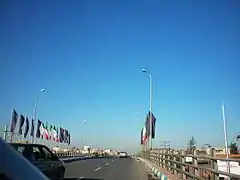 Taleb Amoli Boulevard bridge
Taleb Amoli Boulevard bridge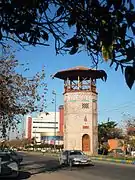 Modarres Boulevard entrance in city from the Tehran
Modarres Boulevard entrance in city from the Tehran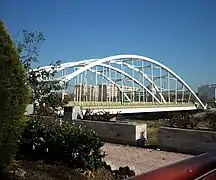 Tabarsi Boulevard bridge (6 Bahman)
Tabarsi Boulevard bridge (6 Bahman)
Customs
International has been a large port in the old days of the port, a major trading port in northern Iran, in the past it has become a city of Mahmoudabad (Ahlam), and now Amol Customs is being operated as part of Amol Customs, Central Customs. It is located in the city of Amol and Amol products are exported to other cities under the supervision of Amol under water, land and air borders.[133]
Science
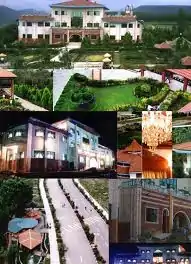
In the third to ninth centuries, Amol had in numbers 70 Khanqah and universities. In the 11th century, Nizam al-Mulk, in his famous book named Siyasatnama, recommended creation of modern institutions by the name of Nezamiyeh with academic status in the large cities of the Islamic world, such as Balkh, Baghdad, Damascus, Neishabour and Bukhara the name of Amol was also included among them. Most of Allameh the Iran are born in this city. also the first seminary by Hasan al-Utrush built in Amol, which was later named Imam Hassan Askari Mosque. Amol at various times was the center of science and culture in Iran, for example, Abu Sa'id Abu'l-Khayr, Muhammad ibn Zakariya al-Razi, Nasir al-Din al-Tusi and Avicenna, Three great men of Iran so-named Polymath respectively students Abul-Abbas Qassab Amoli, Ali ibn Sahl Rabban al-Tabari, Siraj Qumri and Abu Abdullah Al-Natili all three were born and residents of Amol. Also great historian of the world Muhammad ibn Jarir al-Tabari, was from Amol.[134][135] Today likewise, scientific centers such as universities and schools and scientific congresses are active in the city. This branch of Pasteur Institute of Iran is located in the city of Amol in the state of Mazandaran. This institute comprises different departments. Amol with University of Special Modern Technologies and Tehran with Tehran University of Medical Sciences stable hosted of Special Modern Technologies USERN.[136]
Colleges and universities
Some of the biggest universities of Iran such as Shomal University are situated in Amol.
Amol has three universities:
- Shomal University (Non-profit University)
- Amol University of Special Modern Technologies (The first state University of Amol)
- Islamic Azad University, Science and Research Branch, Amol (One of The big University Middle East in terms of area)
- Aban Haraz Institute of Higher Education[137]
- Amol University[138]
- Mazandaran 5 (University of Applied Science and Technology UAST)[139]
- Sabz Institute of Higher Education[140]
- PNU Amol (Payame Noor University)[141]
- Sama College[142]
- Nursing and Paramedical (University of Medical Sciences)[143]
- Pasteur Institute, Iran of Amol[144]
- College of Samangan[145]
- Applied Science Center Fza[146]
- Amol Tohid girls College[147]
- Allameh Hasanzadeh Amoli College[148]
- University of Quranic Sciences[149]
- Farhangian University at Amol[150]
Schools
In Amol, the first new school was established in Niaki neighborhood next to Seyed Hassan Attar residential house, owned by Shir Mohammad Ali Gazaneh, with three classrooms called the Islamic National School. They were able to sign a contract with two brothers, Haji Khan and Mahmoud Khan Golpayegani. The school was opened and started with the management of Haji Khan and Mahmoud Khan's teacher in 1904, one year before the victory of the Persian Constitutional Revolution. Other schools were built during the Pahlavi dynasty, such as Malekzadeh High School, Farhang School, Shahdookht School, Iran Girls' Elementary School, Nusrat School, Shariatzadeh School, Tabari High School, Danesh national primary School and Pahlavi High School.[151] Pahlavi High School that's today is known as Imam Khomeini High School, it was built in 1934 by German architecture engineers. The school was in 2019 registered to Iran National Heritage List.[152]
Sport
Wrestling, Volleyball, Handball, Futsal, Basketball, Boxing, Race car, Mountaineering, Bodybuilding, Karate, Taekwondo and Kung Fu Popular sports in Amol. Kalleh Mazandaran is a volleyball club based in Amol, Asian Club Champions 2013, currently competing in the highest tier of the Iranian volleyball classification, the Iranian Volleyball Super League. Kalleh a Most Popular in Iran and Asia. Kalleh Sports Club also has a basketball team named Kalleh Basketball and Young team volleyball named Kalleh Javan.[153]
Wrestling and volleyball
Amol is the birthplace of many popular Wrestlers and Volleyball athletes. Notable Athlete from Amol include like, Ghasem Rezaei Olympic gold and bronze medalist and Adel Gholami player in national team.[154]
Stadium
- Payambar Azam Arena
- Chamran Stadium
- Kalleh Stadium
Host
- 2007 WAFF Futsal Championship
- West Asian Basketball Championship
- International Fajr Chess Championships 2018
- International Conference of Sport Science 2017
- FIVB Volleyball Coaches Course Level II held in Iran 2018
- Asia Chess Championship 2017
Media
The early in Amol published many newspapers and publications ever since the constitution was a major strength in Mazandaran province. Now, several newspapers and weekly print is active. The first newspaper in Amol the name Mazandaran, Lesan Mellat and Shamshir Mellat released in 1949.[155]
Notable people
- Muhammad ibn Jarir al-Tabari (839–923) – Historian
- Arash the Archer – Legendary hero
- Ali Larijani (b. 1958) – Politician
- Taleb Amoli (b.7th century) – Persian poet
- Ghasem Rezaei (b. 1985) – Wrestler
- Hassan Hassanzadeh Amoli – Philosopher and theologian
- Abdollah Javadi Amoli (b. 1933) – Cleric
- Sahl Ibn Bishr (9th century) – Jewish astrologer
- Ali ibn Sahl Rabban Tabari (9th century) – Medieval physician
- Abu-Sahl Quhi (10th century) – Medieval astronomer and physicist
- Abul Hasan al-Tabari (10th century) – Medieval physician
- Fakhr ad-Din ar-Razi (1149–1209) – Theologian and philosopher
- Ahmad Moshir al-Saltaneh (1260–1337) – Prime minister
- Abdolali Lotfi - Politician and judges
- Farhang Sharif (b. 1931) – Musician
- Ibn Isfandiyar (13th century) – Historian
- Seyyed Hayder Amuli (1319–1385) – Shi'ite mystic and Sufi leader
- Muhammad ibn Mahmud Amuli (14th century) – Medieval physician
- Omar Tiberiades (8th century) – Medieval astrologer
- Manouchehr Khosrodad - Major general
- Abbas Mirza (1789–1833) – Qajar crown prince of Persia
- Qavam al-Din al-Marashi - founder of the Marashi dynasty
- Muhammad Taqi Amoli (1887–1971) – Cleric
- Mirza Hashem Amoli (1899–1993) – Cleric
- Mohammad Taqi Daneshpajouh (1911–1996) – Scholar
- Yahya ibn Abi Mansur (832) – Astronomy
- Haseb-i Tabari (1092–1108) – Astronomy
- Zahiruddin Marashi (1413–1488) – Historian
- Massoud Monfared Niyaki – Major general
- Abul-Abbas Qassab Amoli – Mystic
- Ibn Furak – Theologian
- Ghassem Hashemi Nezhad - Literary critic and writer
- Iraj Malekpour – Physics
- Gholam-Ali Soleimani – Manager
- Mulla Ali Kani (1267–1306) – Learned
- Mohammad-Ali Mirza Dowlatshah (1789–1821) – Qajar dynasty prince
- Iraj Malekpour (b.1941) – Physicist
- Abdol-Qader Gilani (1078–1166) – Sufi leader
- Mohammad-Javad Larijani (b. 1951) – Politician
- Hossein ibn Ebrahim Tabari (10th century) – Medieval physician
- Fatemeh Javadi (b. 1959) – Politician
- Sadeq Larijani (b. 1960) – Cleric and Politician
- Bagher Larijani (b. 1961) – Physician
- Fazel Larijani (b. 1953) – Master
- Adel Gholami (b. 1986) – Volleyball player
- Behrouz Ataei - Volleyball coach
- Ahmad Shariatzadeh - Lawyer
- Khalifeh Soltan – Statesman and cleric
- Abbas Amiri – Actor
- Mohammad Ali Sadjadi (b. 1957) – Director
- Iskandar-i Shaykhi – Afrasiyab dynasty Ruler
- Al-Nagawri – Persian physician
- Ibrahim Khawas – Sufi
- Yaqoub Tavakoli – Historian
- Allahyar Sayyadmanesh – Football player
Health centers and hotels
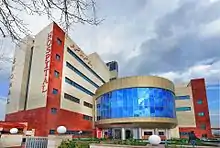
Hotel
- Municipality Hotel (Shahr Hotel)
- Oxin Hotel
- Shomal Olympic Hotel
- Niloofar Hotel
Hospital
- Shomal Hospital (Medical tourism)
- Imam Khomeini Hospital
- Imam Reza Hospital
- 17 Shahrivar Hospital
- Imam Ali Hospital
- Peyman Hospital
- Nik Darman Hospital
Public Service

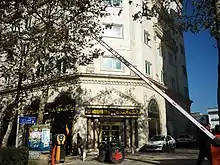
- In Amol there's famous bank representatives
- Amol has a large amusement park in the name Dehkadeh talaei park
- Most restaurants in the province there at Amol
- The city has two Cinemas, Several central library and Three museums is
- Amol also has several local and traditional markets that run weekly. In these markets, vendors and shopkeepers sell their products
Distance
Away with some of the major cities in Iran:
| City | Km distance |
|---|---|
| Sari | 66 |
| Tehran | 185 |
| Ramsar | 181 |
| Mashhad | 810 |
| Astara | 475 |
| Kerman | 1158 |
| Ahvaz | 1001 |
References
- Official website
- "Statistical Center of Iran > Home". www.amar.org.ir. Retrieved Jul 29, 2020.
- Iran Post Website. Postcode.post.ir (2011-07-11). Retrieved on 2012-03-01.
- Amol can be found at GEOnet Names Server, at this link, by opening the Advanced Search box, entering "-3053090" in the "Unique Feature Id" form, and clicking on "Search Database".
- "Census of the Islamic Republic of Iran, 1385 (2006)". Islamic Republic of Iran. Archived from the original (Excel) on 2011-11-11.
- "آمل شهری 3 هزار ساله در تاریخ ایران/ شهری به نام نخستین پایتخت علویان و مرکز اشکانیان- اخبار استانها - اخبار تسنیم - Tasnim". خبرگزاری تسنیم - Tasnim. Retrieved Jul 29, 2020.
- Amol Government
- Amol origin at Hamshahri
- Eurasia book / 178.2
- "Amol". eurasia.travel. Retrieved Jul 29, 2020.
- "ARMY i. Pre-Islamic Iran – Encyclopaedia Iranica". iranicaonline.org. Retrieved Jul 29, 2020.
- Tabaristan History Book, Page 191
- The Persian Empire: A Corpus of Sources from the Achaemenid Period
- Ancient history of Iran in foreign wars / 447.
- The Hyrcani had mustered 6000 as excellent horseman as those nations could furnish, as well as 1000 Tapurian cavalry. The Derbices had armed 40000 foot-soldiers; most of these carried spears tipped with bronze or iron , but some had hardened the wooden shaft by fire. Curtius Rufus Quintus, history of ALEXANDER (3.2.7)
- Parthian History Book by Igor M. Diakonoff
- Encyclopædia Iranica -Amudarya
- Book History Sassanian Emp
- ḤODUD AL-ʿĀLAM – Encyclopaedia Iranica
- Herodotus (1987). The History, translated by David Gren. University of Chicago Press. ISBN 0-226-32770-1. pp. 37-38.
- History Iran (Sassanid Empire) The Rise and Fall of an Empire
- "مازندران در عصر ناصری و ضرابخانههای ۱۳۰۰ ساله". ایرنا. Mar 3, 2020. Retrieved Jul 29, 2020.
- Mentioned in the book, page 142
- Estakhri Book, Page 169
- Ibn Isfandiyar Tarikh-Tabaristan Book
- Madelung, W. (1975). "The Minor Dynasties of Northern Iran". In Frye, R.N. (ed.). The Cambridge History of Iran, Volume 4: From the Arab Invasion to the Saljuqs. Cambridge: Cambridge University Press. pp. 198–249. ISBN 978-0-521-20093-6.
- Bosworth, C.E. (1975). "The Ṭāhirids and Ṣaffārids". In Frye, R.N. (ed.). The Cambridge History of Iran, Volume 4: From the Arab Invasion to the Saljuqs. Cambridge: Cambridge University Press. pp. 90–135.
- ĀL-E Afrasiab
- Amol boasts numerous ancient sites
- Peter Jackson (1986). The Cambridge History of Iran, Volume Six: The Timurid and Safavid Periods. ISBN 0-521-20094-6
- Ed(s). "al- Niẓāmiyya , al- Madrasa." Encyclopaedia of Islam, Second Edition. Edited by: P. Bearman, Th. Bianquis, C.E. Bosworth, E. van Donzel and W.P. Heinrichs. Brill, 2010, retrieved 20(03/2010)
- "Excavation in Amol old city uncovers pottery, glass". Mehr News Agency. Jul 31, 2016. Retrieved Jul 29, 2020.
- Vasily Bartold / An Historical Geography of Iran , Princeton, 1984 translated by Svat Soucek
- History Central Asian, Mazandaran
- H. Ardakani Book
- 1762 Jonas Hanway Travel Trade PERSIA Iran Illustrated MAPS Iraq Russia 2v SET
- The Links between Art and Politics during the Qajar Era
- C. E. BOSWORTH, S. BLAIR, E. EHLERS, About Amol in Iranicaonline
- M. Trezel Book, Page 289
- White Gold - World Economy Newspaper
- Kayhan, Joqrafia III, page. 293-98.
- Iran: A Modern History / Pierre Amedee Emilien Probe Jaubert: Books - Amazon.co.uk
- Rabino itinerary Book
- Mitchell, Colin P. (2009). The Practice of Politics in Safavid Iran: Power, Religion and Rhetoric. I.B.Tauris. pp. 1–304. ISBN 978-0857715883.
- Calmard, J. (Apr 24, 2012). "Marʿas̲h̲is". Encyclopaedia of Islam, Second Edition. Retrieved Jul 29, 2020 – via referenceworks.brillonline.com.
- Book of Constitutional History in Mazandaran
- "آشنایی با شرکت راهآهن جمهوری اسلامی ایران". پایگاه خبری وزارت راه و شهرسازی. Nov 12, 2014. Retrieved Jul 29, 2020.
- "AMĪN-AL-ŻARB, ḤĀJJ MOḤAMMAD-ḤASAN – Encyclopaedia Iranica". iranicaonline.org. Retrieved Jul 29, 2020.
- Taken for Wonder: Nineteenth-Century Travel Accounts from Iran to Europe
- "اینجا قرار بود نخستین کارخانه ذوبآهن ایران باشد(+تصاویر)". ایسنا. Oct 26, 2018. Retrieved Jul 29, 2020.
- A. Enayat, "AMĪN-AL-ŻARB, ḤĀJJ MOḤAMMAD-ḤASAN," Encyclopædia Iranica, I/9, pp. 951-953, available online at (accessed on 30 December 2012).
- Amol History Comprehensive Book / 201, 103, 223 , 89
- "رضا شاه بزرگ - راهآهن سراسری ایران - مشروطه". mashruteh.org. Retrieved Jul 29, 2020.
- "بیست و پنجمین سال شاهنشاهی اعلیحضرت محمدرضا شاه پهلوی آریامهر/ سال ۱۳۴۲ - مشروطه". mashruteh.org. Retrieved Jul 29, 2020.
- "::1982 Amol uprising - ::concepts". www.concepts.org. Retrieved Jul 29, 2020.
- "باید از مردم آمل تشکر کنیم". farsi.khamenei.ir. Retrieved Jul 29, 2020.
- "Cheap flights to Amol | FlightHub". www.flighthub.com. Retrieved Jul 29, 2020.
- Report of the Second National Conference on Construction Participation
- "نمایشگاه - سازمان اسناد و کتابخانه ملی ایران". www.nlai.ir. Retrieved Jul 29, 2020.
- Daryay Mazandaran va piramoon an By Kamal Mahmoudzadeh
- "مـــــازندران - شبکه خبری العالم". fa.alalamtv.net. Retrieved Jul 29, 2020.
- "Sangchal (Bandpay) Earthquake of 02 July 1957, Mw7.0". Jul 2, 2016. Retrieved Jul 29, 2020.
- Towards a Modern Iran: Studies in Thought, Politics and Society
- "اینجا قرار بود نخستین کارخانه ذوبآهن ایران باشد+تصاویر". ایسنا. Oct 27, 2018. Retrieved Jul 29, 2020.
- Haj Muhammad Hassan Amin al-Zarb: His World and His Philosophy of Life
- "نادر شاه افشار و تلاش برای ایجاد نیروی دریایی". bidaran.ir. Retrieved Jul 29, 2020.
- In the time of Nader Shah Afshar
- NAVY i. Nāder Shah and the Iranian Navy / Encyclopædia Iranica
- Persia and the Persian Question, Volume 2 / George Curzon, 1st Marquess Curzon of Kedleston
- Persia and the Persian Question, Volume 1 / George Curzon, 1st Marquess Curzon of Kedleston
- "You are being redirected..." www.ettelaat.com. Retrieved Jul 29, 2020.
- History of construction in the first Pahlavi period
- "شهرنشینی و ساختارهای آن در طبرستان". روزنامه دنیای اقتصاد. Retrieved Jul 29, 2020.
- The Diary of H.M. the Shah of Persia, During His Tour Through Europe in A.D. 1873
- History of commercial houses in the Pahlavi and Qajar eras
- سایت, مدیر وب (Nov 16, 2016). "تاریخچه آب های معدنی در ایران". بخش آشامیدنی فلات قاره. Retrieved Jul 29, 2020.
- MDF sheet history
- "Amol | ToIran, Tourism Platform". www.toiran.com. Retrieved Jul 29, 2020.
- "Arash the Archer The Heroic Archer of Iranian Legend". Retrieved Jul 29, 2020.
- "Iranian Provinces: Mazandaran". www.iranchamber.com. Retrieved Jul 29, 2020.
- "Introduction". mazandaran.rmto.ir. Retrieved Jul 29, 2020.
- "50th anniversary of Caspian horse's rediscovery". Retrieved Jul 29, 2020.
- "نمایش صفحه ای | مدیریت منابع آب ایران". daminfo.wrm.ir. Retrieved Jul 29, 2020.
- "NIORDC Expanding Cooperation With East Asian Companies". Financial Tribune. Jan 8, 2017. Retrieved Jul 29, 2020.
- "Climate: Amol – Climate graph, Temperature graph, Climate table". Climate-Data.org. Retrieved 9 September 2013.
- There are Bronze Age architecture at Amol
- "Iran Statistics Institute". Archived from the original on 2011-07-11. Retrieved 1 June 2012.
- "CALENDARS – Encyclopaedia Iranica". iranicaonline.org. Retrieved Jul 29, 2020.
- "Mazandarani language, alphabet and pronunciation". omniglot.com. Retrieved Jul 29, 2020.
- "Iranian Political Geography". Retrieved Jul 29, 2020.
- Amol exports to seven countries
- "36 tons of trout exports from Astara to Russia". IRNA English. Jul 19, 2017. Retrieved Jul 29, 2020.
- C. E. Bosworth, S. Blair, E. Ehlers, "ĀMOL"
- "Rice Research Institute of Iran". Archived from the original on 2016-12-03. Retrieved 2016-12-02.
- Technology Development Center in Amol,
- "Int'l Rice Export Terminal Opens in Northern Iran". Eghtesad Online. Retrieved Jul 29, 2020.
- "Iranian private sector opens International Rice Trade Centre & Export Terminal". Iran Chamber Newsroom. Retrieved Jul 29, 2020.
- "برگزاری جشن اولین نشای مکانیزه برنج سال 97 درکشور در روستای فیروزکلا دشت سر شهرستان آمل". jkmaz.ir. Jan 15, 1397. Retrieved Jul 29, 2020.
- "Industry Mazandaran". Retrieved Jul 29, 2020.
- "Solico Food Industries". www.solico-group.com. Retrieved Jul 29, 2020.
- Mazandaran Industry in the Islamic Republic / ISNA
- About Us. Dairy.kalleh.com. Retrieved on 2012-03-01.
- شرکت فولادین ذوب آمل – فذا. Fzaco.com. Retrieved on 2012-03-01.
- "كارخانه توليد كاغذ اسناد بهادار". Cbi.ir. Retrieved 2012-03-01.
- الکتریک, خزر (Jul 29, 2015). "خزر الکتریک". خزر الکتریک. Retrieved Jul 29, 2020.
- "شرکت لبنیات هراز". www.doosheh.com. Retrieved Jul 29, 2020.
- "صفحه نخست". صنایع غذایی دلوسه. Retrieved Jul 29, 2020.
- POLUR. Polurco.com. Retrieved on 2012-03-01.
- "Home Nestlé Iran". Nestle.ir. Archived from the original on 2012-02-23. Retrieved 2012-03-01.
- "Zarbal". Zarbal.com. Archived from the original on 2012-02-17. Retrieved 2012-03-01.
- "صنایع آلومینیومی آبسکون | شرکت آبسکون تولید کننده پروفیل آلومینیومی | صفحه اصلی". صنایع آلومینیوم آبسکون. Retrieved Jul 29, 2020.
- "Homeگروه صنعتی نساجی بابکان". babakanco.com. Retrieved Jul 29, 2020.
- "سايت ارس بازار". abcdaroo.com. Retrieved Jul 29, 2020.
- "برابری تولید آبزیان پرورشی در آمل با دریای مازندران". خبرگزاری مهر اخبار ایران و جهان ; Mehr News Agency. Feb 7, 2012. Retrieved Jul 29, 2020.
- "Tirgan: The Festival of Rain". www.iranreview.org. Retrieved Jul 29, 2020.
- "Iran 2 cities to host Jasmine Filmfest". Archived from the original on 2016-11-30. Retrieved 2016-11-30.
- History of architecture Amol
- "Mir-Buzurg Tomb". Retrieved September 4, 2006.
- "Big naser Tomb tower". Retrieved September 4, 2006.
- "Tomb tower Mir Haydar". Retrieved September 4, 2006.
- www.sirang.com, Sirang Rasaneh. "Amol Bazaar 2020 Tourist Attraction in Amol, travel to iran, Visit Iran". itto.org | Iran Tourism & Touring. Retrieved Jul 29, 2020.
- www.sirang.com, Sirang Rasaneh. "Ashraf Bath 2020 Tourist Attraction in Amol, travel to iran, Visit Iran". itto.org | Iran Tourism & Touring. Retrieved Jul 29, 2020.
- www.sirang.com, Sirang Rasaneh. "Imamzadeh Abdollah 2020 Tourist Attraction in Amol, travel to iran, Visit Iran". itto.org | Iran Tourism & Touring. Retrieved Jul 29, 2020.
- "Shrine Taher". Retrieved September 4, 2006.
- www.sirang.com, Sirang Rasaneh. "Ab Esk (Larijan) Thermal Springs 2020 Tourist Attraction in Amol, travel to iran, Visit Iran". itto.org | Iran Tourism & Touring. Retrieved Jul 29, 2020.
- Encyclopaedia / Amol in over time
- "معروفترین سوغات استان مازندران؛ ازخوراکی تا صنایع دستی". Retrieved Jul 29, 2020.
- "سوغات مازندران و شهرهای مختلف این استان با عکس | این تودی". Aug 18, 2019. Retrieved Jul 29, 2020.
- The first helicopter air ambulance in Iran
- "Railroads i. The First Railroad Built and Operated in Persia". Archived from the original on 26 June 2019. Retrieved 26 June 2019.
- Curzon, George Nathaniel (Feb 5, 2016). Persia and the Persian Question. Cambridge University Press. ISBN 9781108080842. Retrieved Jul 29, 2020 – via Google Books.
- "عملیات قطعه دوم پروژه راه آهن برقی آمل تهران اجرایی میشود". تین نیوز. Retrieved Jul 29, 2020.
- Naderi Beni, A.; Lahijani, H.; Mousavi Harami, R.; Arpe, K.; Leroy, S. a. G.; Marriner, N.; Berberian, M.; Andrieu-Ponel, V.; Djamali, M.; Mahboubi, A.; Reimer, P. J. (Jul 29, 2013). "Caspian sea-level changes during the last millennium: historical and geological evidence from the south Caspian Sea". Climate of the Past. 9 (4): 1645–1665. Bibcode:2013CliPa...9.1645N. doi:10.5194/cp-9-1645-2013. Retrieved Jul 29, 2020 – via cp.copernicus.org.
- "Muhammad ibn Jarir al-Tabari Facts". biography.yourdictionary.com. Retrieved Jul 29, 2020.
- Merriam-Webster's Encyclopedia of World Religions
- "News - USERN". usern.tums.ac.ir. Retrieved Jul 29, 2020.
- "موسسه آموزش عالی آبان هراز". haraz.ac.ir. Retrieved Jul 29, 2020.
- موسسه آموزش عالی آمل – صفحه اصلی. Amol.ac.ir. Retrieved on 2012-03-01.
- دانشگاه علمي كاربردي واحد 5 مازندارن – آمل Archived 2011-10-24 at the Wayback Machine. Uast-amol.ac.ir. Retrieved on 2012-03-01.
- موسسه آموزش عالی سبز. Sabz.ac.ir. Retrieved on 2012-03-01.
- "دانشگاه پیام نور مرکز آمل". Pnuamol.ac.ir. Retrieved 2013-05-19.
- دانشگاه آزاد اسلامی – آموزشکده فنی و حرفه ای سما واحد آیت اله آملی. Amol-samacollege.ir. Retrieved on 2012-03-01.
- "fnamol.mazums.ac.ir". Archived from the original on 2011-07-26. Retrieved 2012-02-15.
- Institut pasteur d'Iran. Pasteur.ac.ir. Retrieved on 2012-03-01.
- "موسسه آموزش عالی غیرانتفاعی سمنگان". Samangan.ac.ir. Retrieved 2013-05-19.
- "- دانشگاه علمی کاربردی فذا". fza-uast.ac.ir. Retrieved Jul 29, 2020.
- "خانه". دانشگاه فنی و حرفه ای. Retrieved Jul 29, 2020.
- "خانه". دانشگاه فنی و حرفه ای. Retrieved Jul 29, 2020.
- "دانشکده علوم قرآنی آمل". amol.quran.ac.ir. Retrieved Jul 29, 2020.
- TC Amol Cdu.ac.ir
- A book examining the functional changes of Amol market from the past to the present / Dr. Nasser Fekouhi
- "مدرسه ماندگار آمل در فهرست میراث ملی ثبت شد/ ثبت ۷۰ اثر میراثی". خبرگزاری مهر | اخبار ایران و جهان | Mehr News Agency. Sep 5, 2019. Retrieved Jul 29, 2020.
- "Volleyball news, transfers, interviews and blogs". worldofvolley.com. Retrieved Jul 29, 2020.
- "FILA Legends: 2012 Olympian Ghasem Rezaei". United World Wrestling. Retrieved Jul 29, 2020.
- History of Mazandaran Press to Safar Mazandaran Newspaper by Naser al-Din Shah
- Syed Shayan (February 2015). "Ground Realities 4". Akhbar Peela. Archived from the original on 5 March 2016. Retrieved 23 October 2015.
External links
| Wikimedia Commons has media related to Amol. |
- Tourismo Amol
- chnpress.com
- lovelyiran.com
- itto.org
- parrpirar.org
- Yourwonder Amol
- Amol Chto
- Amol DataBase
- english.irib.ir


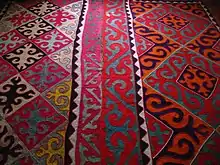

.jpg.webp)

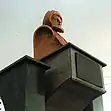
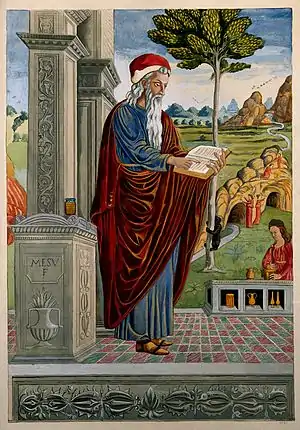
.jpeg.webp)
.jpg.webp)
